Hartsfield–Jackson Atlanta International Airport
| Hartsfield–Jackson Atlanta International Airport | |||||||||||||||||||||||||||
|---|---|---|---|---|---|---|---|---|---|---|---|---|---|---|---|---|---|---|---|---|---|---|---|---|---|---|---|
 | |||||||||||||||||||||||||||
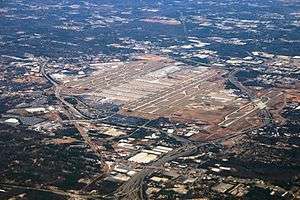 | |||||||||||||||||||||||||||
|
IATA: ATL – ICAO: KATL – FAA LID: ATL – WMO: 72219 | |||||||||||||||||||||||||||
| Summary | |||||||||||||||||||||||||||
| Airport type | Public | ||||||||||||||||||||||||||
| Owner | City of Atlanta | ||||||||||||||||||||||||||
| Operator | Atlanta Department of Aviation | ||||||||||||||||||||||||||
| Serves | Atlanta, Georgia | ||||||||||||||||||||||||||
| Location |
unincorporated areas, Atlanta, College Park, and Hapeville Fulton & Clayton Counties | ||||||||||||||||||||||||||
| Hub for | |||||||||||||||||||||||||||
| Focus city for | |||||||||||||||||||||||||||
| Elevation AMSL | 1,026 ft / 313 m | ||||||||||||||||||||||||||
| Coordinates | 33°38′12″N 084°25′41″W / 33.63667°N 84.42806°WCoordinates: 33°38′12″N 084°25′41″W / 33.63667°N 84.42806°W | ||||||||||||||||||||||||||
| Website | atlanta-airport.com | ||||||||||||||||||||||||||
| Maps | |||||||||||||||||||||||||||
 FAA airport diagram | |||||||||||||||||||||||||||
 ATL Location of airport in Metro Atlanta | |||||||||||||||||||||||||||
| Runways | |||||||||||||||||||||||||||
| |||||||||||||||||||||||||||
| Helipads | |||||||||||||||||||||||||||
| |||||||||||||||||||||||||||
| Statistics (2015[2]) | |||||||||||||||||||||||||||
| |||||||||||||||||||||||||||

Hartsfield–Jackson Atlanta International Airport (IATA: ATL, ICAO: KATL, FAA LID: ATL), known locally as Atlanta Airport, Hartsfield, or Hartsfield–Jackson, is located seven miles (11 km) south of the central business district of Atlanta, Georgia, United States. It has been the world's busiest airport by passenger traffic since 1998, and by number of landings and take-offs from 2005 until 2013.[3] Hartsfield–Jackson held its ranking as the world's busiest airport in 2012, both in passengers and number of flights, by accommodating 100 million passengers (more than 260,000 passengers daily) and 950,119 flights.[4][5][6] Many of the nearly one million flights are domestic flights from within the United States, where Atlanta serves as a major hub for travel throughout the Southeastern United States. The airport has 207 domestic and international gates.[7]
Hartsfield–Jackson is the primary hub of Delta Air Lines, Delta Connection, and Delta Air Lines partner, ExpressJet and is a focus city for low-cost carriers Frontier Airlines, Southwest Airlines, and Spirit Airlines. American Airlines also carries many operations from the airport. With nearly 1,000 flights a day, the Delta Air Lines hub is the world's largest hub.[8] Delta Air Lines flew 59.01% of passengers from the airport in February 2011, AirTran flew 17.76%, and ExpressJet flew 13.86%.[9] In addition to hosting Delta Air Lines corporate headquarters, Hartsfield–Jackson is also the home of Delta's Technical Operations Center, which is the airline's primary maintenance, repair and overhaul arm.[10] The airport has international service to North America, South America, Central America, Europe, Asia and Africa. As an international gateway to the United States, Hartsfield–Jackson ranks sixth.[4]
The airport is located mostly in unincorporated areas in Fulton and Clayton counties. However, the airport spills into the city limits of Atlanta,[11] College Park[12] and Hapeville.[13] The airport's domestic terminal is served by MARTA's Red/Gold rail line.
History
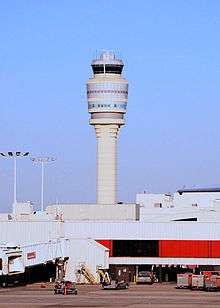
Hartsfield–Jackson had its beginnings with a five-year, rent-free lease on 287 acres (116 ha) that was the home of an abandoned auto racetrack named The Atlanta Speedway. The lease was signed April 16, 1925, by Mayor Walter Sims, who committed the city to develop it into an airfield. As part of the agreement, the property was renamed Candler Field after its former owner, Coca-Cola tycoon and former Atlanta mayor Asa Candler. The first flight into Candler Field was September 15, 1926, a Florida Airways mail plane flying from Jacksonville, Florida. In May 1928, Pitcairn Aviation began service to Atlanta, followed in June 1930 by Delta Air Service. Later those two airlines, now known as Eastern Air Lines and Delta Air Lines, respectively, would both use Atlanta as their chief hubs.[14] The airport's weather station became the official location for Atlanta's weather observations September 1, 1928, and records by the National Weather Service.[15]
It was a busy airport from its inception and by the end of 1930 it was third behind New York City and Chicago for regular daily flights with sixteen arriving and departing.[16] (In May 1931 Atlanta had four scheduled departures.) Candler Field's first control tower opened March 1939.[17] The March 1939 Official Aviation Guide shows fourteen weekday airline departures: ten Eastern and four Delta.[18]
In October 1940, the U.S. government declared it a military airfield and the United States Army Air Forces operated Atlanta Army Airfield jointly with Candler Field. The Air Force used the airport primarily for servicing of transient aircraft, with many types of combat aircraft being maintained at the airport. During World War II the airport doubled in size and set a record of 1,700 takeoffs and landings in a single day, making it the nation's busiest airport in terms of flight operation. Atlanta Army Airfield closed after the war.[17]
In 1946 Candler Field was renamed Atlanta Municipal Airport and by 1948, more than one million passengers passed through a war surplus hangar that served as a terminal building. Delta and Eastern had extensive networks from ATL, though Atlanta had no nonstop flights beyond Texas, St Louis and Chicago until 1961. Southern Airways established itself at ATL after the war and had short-haul routes around the Southeast until 1979.
On June 1, 1956, an Eastern Airlines flight to Montreal, Canada was the first scheduled international flight out of Atlanta. Atlanta's first scheduled trans-Atlantic flight was the Delta/Pan Am interchange DC-8 to Europe starting in 1964; the first scheduled nonstop to Mexico was Eastern's flight to Mexico City around 1972. Nonstops to Europe started in 1978 and to Asia in 1992–93.
In 1957 Atlanta saw its first jet airliner: a prototype Sud Aviation Caravelle that was touring the country arrived from Washington D.C. The first scheduled turbine airliners were Capital Viscounts in June 1956; the first scheduled jets were Delta DC-8s in September 1959.
Atlanta says ATL was the busiest airport in the country with more than two million passengers passing through in 1957 and, between noon and 2 p.m. each day, it became the busiest airport in the world.[17] (The April 1957 OAG shows 165 weekday departures from Atlanta, including 45 between 12:05 and 2:00 PM (and 20 between 2:25 and 4:25 AM). Chicago Midway had 414 weekday departures, including 48 between 12:00 and 2:00 PM. For the year 1957 Atlanta was the ninth busiest airline airport in the country by flight count and about the same by passenger count.)
That year work began on a new $21 million terminal which opened May 3, 1961. It was the largest in the country and could handle over six million travelers a year; the first year nine and half million people passed through.[19] In March 1962 the longest runway (9/27, now 8R) was 7,860 feet (2,400 m); runway 3 was 5,505 feet (1,678 m) and runway 15 was 7,220 feet (2,200 m) long.
The airport's terminal until the 1970s was located off Virginia Avenue, on the north side of the airport. It was designed around six pier concourses radiating from a central building.[20] Construction began on the present midfield terminal in January 1977 under the administration of Mayor Maynard Jackson. It was the largest construction project in the South, costing $500 million. The complex was designed by Stevens & Wilkinson, Smith Hinchman & Grylls, and Minority Airport Architects & Planners.[21] Named for former Atlanta mayor William Berry Hartsfield, who did much to promote air travel, William B. Hartsfield Atlanta International Airport opened on September 21, 1980, on-time and under budget.[22] It was designed to accommodate up to 55 million passengers per year and covered 2.5 million square feet (230,000 m²). In December 1984 a 9,000-foot (2,700 m) fourth parallel runway was completed and another runway was extended to 11,889 feet (3,624 m) the following year.[17]

Although Eastern was a larger airline than Delta until airline deregulation in 1978, Delta was early to adopt the hub and spoke route system, with Atlanta as its primary hub between the Midwest and Florida, giving it an advantage in the Atlanta market. Eastern ceased operations in 1991 due to labor issues leaving Delta with the only major airline hub in Atlanta. American Airlines considered establishing an Atlanta hub around the time of Eastern's demise, but determined that Delta was already too strong there and that the competitive environment was more favorable at Eastern's other hub in Miami.[23]
_(2527719317).jpg)
ValuJet was established in 1993 as low-cost competition for Delta at ATL. However, its safety practices were called into question early and the airline was grounded after the 1996 crash of ValuJet Flight 592. It resumed operations in 1997 as AirTran Airways and was the second-largest airline at ATL until it was acquired by Southwest Airlines in 2011 and fully absorbed into Southwest on December 28, 2014. Southwest is now the airport's second largest carrier.
In May 2001 construction of a 9,000-foot (2,700 m) fifth runway (10–28) began. It was completed at a cost of $1.28 billion and opened on May 27, 2006.[24] It bridges Interstate 285 (the Perimeter) on the south side of the airport, making Hartsfield–Jackson the only civil airport in the nation to have a runway above an interstate (although Runway 17R/35L at Stapleton International Airport in Denver crossed Interstate 70 until that airport closed in 1995). The massive project, which involved putting fill dirt eleven-stories high in some places, destroyed some surrounding neighborhoods and dramatically changed the scenery of Flat Rock Cemetery and Hart Cemetery, both of which are located on the airport property.[25] It was added to help ease some of the traffic problems caused by landing small- and mid-size aircraft on the longer runways which are also used by larger planes such as the Boeing 777, which need longer runways than the smaller planes. With the fifth runway, Hartsfield–Jackson is one of only a few airports that can perform triple simultaneous landings.[26] The fifth runway is expected to increase the capacity for landings and take-offs by 40%, from an average of 184 flights per hour to 237 flights per hour.[27]
Along with the construction of the fifth runway, a new control tower was built to see the entire length of the runway. The new control tower is the tallest in the United States, with a height of over 398 feet (121 m). The old control tower, 585 feet (178 m) away from the new control tower, was demolished August 5, 2006.[28]
Atlanta City Council voted on October 20, 2003, to change the name from Hartsfield Atlanta International Airport to the current Hartsfield–Jackson Atlanta International Airport, to honor former mayor Maynard Jackson, who died June 23, 2003. The council initially planned on renaming the airport solely for Mayor Jackson, but public outcry prevented this.[29][30]
In April 2007 an "end-around taxiway" opened, Taxiway Victor. It is expected to save an estimated $26 million to $30 million in fuel each year by allowing airplanes landing on the northernmost runway to taxi to the gate area without preventing other aircraft from taking off. The taxiway drops about 30 feet (9.1 m) from runway elevation to allow takeoffs to continue.[31]
After the Southeastern U.S. drought of 2007, the airport (the eighth-largest water user in the state) made changes to reduce water usage. This included adjusting toilets, of which there are 725 commodes and 338 urinals, in addition to 601 sinks. (The two terminals alone use 917,000 gallons or about 3.5 million liters each day on average.) It also suspended the practice of using firetrucks to spray water over aircraft when the pilot made a last landing before retirement (a water salute).[32][33] The city of Macon offered to sell water to the airport, through a proposed pipeline.[34] Many of the new high-efficiency toilets and faucets installed at the airport were made by TOTO, a Japanese company known for water conservation with two local plants in the Atlanta suburb of Morrow.
The airport today employs about 55,300 airline, ground transportation, concessionaire, security, federal government, City of Atlanta and Airport tenant employees and is the largest employment center in the U.S. state of Georgia. With a payroll of $2.4 billion, the airport has a direct and indirect economic impact of $3.2 billion on the local and regional economy and a total annual, regional economic impact of more than $19.8 billion.[35] Since the opening of Concourse F in May 2012, the airport now has 200 gates which is the most at any airport.
In December 2015, the airport became the first airport in the world to serve 100 million passengers in a year.[36]
Expansion and renovations
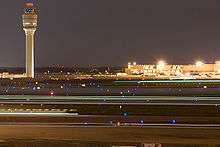
In 1999, Hartsfield–Jackson's leadership established the Development Program: "Focus On the Future" involving multiple construction projects with the intention of preparing the airport to handle a projected demand of 121 million passengers in 2015. The program was originally budgeted at $5.4 billion over a ten-year period, but the total is now revised to be at over $9 billion.[37]
Hartsfield–Jackson Rental Car Center
The Hartsfield–Jackson Rental Car Center, which opened December 8, 2009, houses all ten current airport rental agencies with capacity for additional companies. The complex features 9,900 parking spaces split between two four-story parking decks that together cover 2,800,000 square feet (260,000 m2), a 137,000-square-foot (12,700 m2) customer service center, a maintenance center for vehicles which features 140 gas pumps and 30 wash bays equipped with a water recovery system. The automated people mover, nicknamed the ATL Skytrain, (using Mitsubishi Crystal Mover equipment) connects the facility to the airport, the Gateway Center of the Georgia International Convention Center and the Hartsfield–Jackson Rental Car Center.[38] A four-lane roadway was built across Interstate 85 to connect the Hartsfield–Jackson Rental Car Center to the existing airport road network.[39]
Maynard H. Jackson Jr. International Terminal
In July 2003, former Atlanta mayor Shirley Franklin announced a new terminal to be named for Maynard H. Jackson, Jr.. The new international terminal would be built on the east side of the airport near International Concourse E, on a site that had been occupied by air cargo facilities and the midfield control tower. It has added twelve new gates able to hold wide-body jets, which can be converted to sixteen narrow-body gates, as well as new check-in desks and a baggage claim area solely for international carriers. Additionally, the international terminal has its own parking lot just for international passengers with over 1,100 spaces. Arriving international passengers whose final destination is Atlanta are able to keep possession of their luggage as they proceed to exit the airport. The new terminal is connected to Concourse E by the tram and also has ground transportation access via I-75.[40] The new terminal was slated to open in 2006; however, time and cost overruns led former Airport General Manager Ben DeCosta to cancel the design contract in August 2005. The next day, the architect sued the airport claiming "fraud" and "bad faith", blaming the airport authority for the problems.[41] In early 2007, the General Manager awarded a new design contract on the new international terminal to Atlanta Gateway Designers (AGD). Construction began in the summer of 2008. Estimates place the terminal's cost at $1.4 billion and it opened on May 16, 2012.[42] The first departure was Delta Flight #295 to Tokyo–Narita, with the first arrival being Delta Flight #177 from Dublin.
Accommodating the A380
In addition to the terminal that will expand international operations at the airport, sections of some midfield taxiways have been widened from 145 feet (44 m) to 162 feet (49 m) and a section of Runway 27R has been widened from 220 feet (67.1 m) to 250 feet (76.2m) in order to accommodate Airbus A380 operations at the airport. Air France is considering whether they will commence A380 service from Atlanta, and Korean Air began daily service from Atlanta to Seoul on September 1, 2013.[43][44] Additionally, two adjacent gates on Concourse E, Gates E1 and E3, have been retrofitted to allow lower-level boarding from one gate and upper-level boarding from the other, allowing for quick boarding and the facilitation of passengers to other connecting flights around the airport.[45]
Modernization of Concourse D
On June 6, 2011, Atlanta City Council awarded a contract to the joint venture of Holder/Moody/Bryson to renovate and expand Concourse D. There will be 60,000 square feet (5,600 m2) of space added, two new escalators between the main level and the Transportation Mall, three new elevators between the second and third levels, and there will be both expanded and new food, beverage and retail outlets. The project budget is not to exceed $37 million and it is set for completion by spring 2014.[45][46][47][48][49]
2014 master plan
On August 28, 2014, the airport management unveiled a preliminary new master plan.[50] Included in the master plan are the replacement of the existing domestic parking garages, an end-around taxiway and additional cargo facilities on the south side of the airport, the addition of three new international concourses (G, H, and I), the conversion of Concourse E to domestic use and a sixth runway.
Terminals
Layout
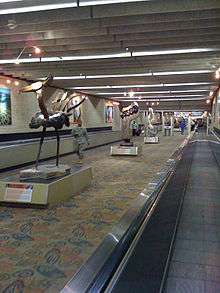
Hartsfield–Jackson Atlanta International Airport has terminal and concourse space totaling 6,800,000 square feet (630,000 m2).[7] The airport has two terminals where passengers check-in and claim bags, the Domestic Terminal and the Maynard H. Jackson, Jr. International Terminal. The Domestic Terminal is on the west side of the airport. The Maynard H. Jackson, Jr. International Terminal is located on the east side of the airport, and includes Customs and Immigration services for international passengers.
Seven parallel concourse buildings accommodate passenger boarding and are located between the two terminals. Concourse T is connected to the Domestic Terminal. The remaining six concourses from west to east are Concourses A, B, C, D, E, and F.[7] Concourses A–D and T are used for domestic flights, while Concourses E and F are used for international flights. Concourse F is directly connected to the International Terminal. Concourse E has a designated walkway to the international terminal and also has its own Federal Inspection station for connecting passengers. Concourse F and the International Terminal opened in 2012. Concourse E opened in 1994 for international flights in time for the 1996 Summer Olympic Games, which were held in Atlanta.[17] Prior to the opening of Concourse E, the north side of Concourse T housed international flights.
The terminals and concourses are connected by an underground Transportation Mall which passes under the center of each concourse.[51] At one time, there was a second underground walkway between Concourses B and C which connected the north end of the two concourses and made it possible to transfer without returning to the center of the concourse. This was constructed for Eastern Airlines, which occupied these two terminals. This is now closed and the entrance at Concourse B has been replaced by a bank of arrival/departure monitors.
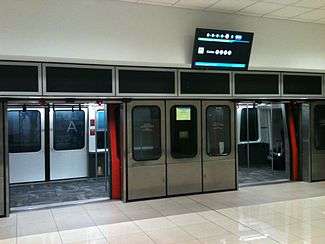
Domestic terminal
The domestic terminal is divided into two sides for ticketing, check-in and baggage claim, Terminal South and Terminal North. The portion of the building between Terminal North and Terminal South includes the Atrium, which is a large, open seating area featuring concessionaires, a bank, conference rooms, an interfaith chapel and offices on the upper floors with the main security checkpoint, the Ground Transportation Center and a Metropolitan Atlanta Rapid Transit Authority (MARTA) train station on other levels.[52]
Delta Air Lines is the sole tenant located at Terminal South; all other domestic airlines operating from Atlanta, including the airport's second largest carrier, Southwest Airlines, are located at Terminal North. Most domestic flights arrive and depart within concourses T, A, B, C or D. Some domestic flights depart from concourses E & F when gates at T or A–D are not available, or when an aircraft arrives as an international flight and continues as a domestic flight.
Maynard Holbrook Jackson Jr. International Terminal
All international flights arrive and depart from the international terminal, either concourse E or F. Concourse F and the new international terminal opened May 16, 2012, while concourse E previously opened in September 1994, in anticipation of the 1996 Summer Olympics. International pre-cleared flights can arrive at concourses T & A–D. International flights can also depart from concourses T & A–D, such as when space is unavailable at concourses E or F, or when an aircraft arrives as a domestic flight and continues as an international flight. Furthermore, all international pre-cleared flights, regardless of origin, will collect their baggage at the international terminal.
Concourses
All concourses are served by Delta, and the other airlines are split up between the airport's concourses as follows:
- Concourse T – 17 gates (T1–T17) – also used by American and United
- Concourse A – 29 gates (A1–A7, A9–A12, A15–A21, A24–A34) - only used by Delta
- Concourse B – 32 gates (B1–B7, B9–B14, B16–B29, B31–B34, B36) - only used by Delta
- Concourse C – 48 gates (C1–C22, C30-53, C55, C57) – also used by Southwest
- Concourse D – 43 gates (D1, D1A, D2–D8, D8A, D9–D11, D11A, D12–D16, D21–D42, D44, D46) – also used by Alaska, American, Frontier, and Spirit
- Concourse E – 28 gates (E1–E12, E14–E18, E26–E36) and 3 stands (6NA–6NC) – also used by all international airlines except Air Canada
- Concourse F – 12 gates (F1–F10, F12, F14) – also used by Air Canada, Southwest and all international airlines
- Note: All international arrivals (except flights with customs pre-clearance) are handled at Concourses E and F.
Transportation Mall and the Plane Train
In addition to a pedestrian walkway, which includes a series of moving walkways, connecting the concourses, the Transportation Mall also features an automated people mover called the Plane Train. The Plane Train has a station at the east end of the domestic terminal for passengers who have cleared security screening at that terminal and are entering the Transportation Mall. This station also serves as the station for Concourse T. Other stations are located at each of the six other concourses, including concourse F which is connected to the international terminal. An eighth station is located in the baggage claim area, directly under the Main Terminal. The people mover is the world's busiest automated system, with over 64 million riders in 2002.[51]
Airlines and destinations
- Note: All international arrivals (except flights with customs pre-clearance) are handled at Concourses E and F.
Passenger
Cargo
Statistics
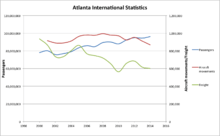
Top destinations
| Rank | Airport | Passengers | Carriers |
|---|---|---|---|
| 1 | Orlando, Florida | 1,362,000 | Delta, Frontier, Southwest, Spirit |
| 2 | Fort Lauderdale, Florida | 1,195,000 | Delta, Southwest, Spirit |
| 3 | New York–LaGuardia, New York | 1,078,000 | American, Delta, Frontier, Southwest |
| 4 | Tampa, Florida | 1,029,000 | Delta, Southwest, Spirit |
| 5 | Dallas/Fort Worth, Texas | 999,000 | American, Delta, Spirit |
| 6 | Los Angeles, California | 998,000 | American, Delta, Frontier, Southwest, Spirit |
| 7 | Chicago–O'Hare, Illinois | 938,000 | American, Delta, Frontier, Spirit, United |
| 8 | Charlotte, North Carolina | 937,000 | American/US Airways, Delta |
| 9 | Philadelphia, Pennsylvania | 913,000 | American/US Airways, Delta, Frontier, Southwest, Spirit |
| 10 | Washington–National, D.C. | 854,000 | Delta, Southwest |
| Rank | Airport | Passengers | Carriers |
|---|---|---|---|
| 1 | Cancún, Mexico | 704,881 | Southwest, Delta |
| 2 | Paris (Charles de Gaulle), France | 667,762 | Delta, Air France |
| 3 | Amsterdam, Netherlands | 649,602 | KLM, Delta |
| 4 | London (Heathrow), United Kingdom | 563,480 | British Airways, Delta, Virgin Atlantic |
| 5 | Mexico City, Mexico | 440,239 | Delta |
| 6 | Montego Bay, Jamaica | 409,872 | Delta |
| 7 | Toronto (Pearson), Canada | 379,965 | Air Canada, Delta |
| 8 | Nassau, Bahamas | 335,244 | Delta |
| 9 | Frankfurt, Germany | 292,555 | Delta, Lufthansa |
| 10 | Seoul (Incheon), Korea | 256,086 | Korean Air |
| 11 | Punta Cana, Dominican Republic | 294,513 | Delta, Southwest |
| 12 | São Paulo,Brazil | 249,102 | Delta |
| 13 | Tokyo, Japan | 244,463 | Delta |
| 14 | Rome, Italy | 182,514 | Delta |
| 15 | Johannesburg, South Africa | 184,931 | Delta |
| 16 | Dubai, United Arab Emirates | 178,107 | Delta |
- Airline market share
| Rank | Airline | Passengers |
|---|---|---|
| 1 | Delta Air Lines | 40,444,909 |
| 2 | Southwest Airlines | 4,623,485 |
| 3 | American Airlines1 | 1,597,081 |
| 4 | United Airlines | 745,966 |
| 5 | Frontier Airlines | 510,729 |
| 6 | Spirit Airlines | 431,229 |
| 7 | Air France | 221,632 |
| 8 | Virgin Atlantic | 136,989 |
| 9 | KLM | 122,857 |
| 10 | Korean Air | 104,801 |
Notes
- ^1 Includes US Airways
- Annual traffic
| Passengers | Change from previous year | Aircraft operations | Cargo tonnage[69] | |
|---|---|---|---|---|
| 2000 | 78,092,940 | | N/A | 935,892 |
| 2001 | 80,162,407 | | 915,454 | 865,991 |
| 2002 | 75,858,500 | | 890,494 | 735,796 |
| 2003 | 76,876,128 | | 889,966 | 734,083 |
| 2004 | 79,087,928 | | 911,727 | 802,248 |
| 2005 | 83,606,583 | | 964,858 | 862,230 |
| 2006 | 85,907,423 | | 980,386 | 767,897 |
| 2007 | 84,846,639 | | 976,447 | 746,502 |
| 2008 | 89,379,287 | | 994,346 | 720,209 |
| 2009 | 90,039,280 | | 978,824 | 655,277 |
| 2010 | 88,001,381 | | 970,235 | 563,139 |
| 2011[70] | 92,389,023 | | 923,996 | 659,129 |
| 2012 | 94,956,643 | | 952,767 | 684,576 |
| 2013 | 94,431,224 | | 911,074 | 616,365 |
| 2014 | 96,178,899 | | 868,359 | 601,270 |
| 2015 | 101,491,106 | | 882,497 | 626,201 |
| Source: Hartsfield–Jackson Atlanta International Airport[4] | ||||
Ground transportation
Road
The domestic terminal is accessed directly from Interstate 85 at exit 72. The international terminal is accessed directly from Interstate 75 at exit 239. These freeways in turn connect with the following additional freeways within 10 miles: Interstate 285, Interstate 675, Georgia State Route 166, Interstate 20.
Metro
Hartsfield–Jackson also has its own train station on the city's rapid transit system, MARTA. The above-ground station is inside in the main building, between the north and south terminals on the west end. The Airport train station is currently the southernmost station in the MARTA system.[71]
Other facilities
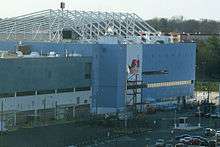
The 990 Toffie Terrace hangar, a part of Hartsfield–Jackson Airport,[72] and located the City of College Park corporate limits, is owned by the City of Atlanta.[12] The building now houses the Atlanta Police Department Helicopter Unit.[73][74] It once served as the headquarters of the regional airline ExpressJet.[75]
Before the merger, Atlantic Southeast Airlines headquartered in the hangar, then named the A-Tech Center.[76] In December 2007, the airline announced it was moving its headquarters into the facility, previously named the "North Hangar." The 203,000-square-foot (18,900 m2) hangar includes 100,000 square feet (9,300 m2) of hangar bays for aircraft maintenance. It has 17 acres (6.9 ha) of adjacent land and 1,400 parking spaces for employees. The airline planned to relocate 100 employees from Macon, Georgia to the new headquarters. The Atlanta City Council and Mayor of Atlanta Shirley Franklin approved of the new 25-year ASA lease, which also gave the airline new hangar space to work on 15 to 25 aircraft in overnight maintenance; previously its aircraft were serviced at Concourse C. The airport property division stated that the hangar was built in the 1960s and renovated in the 1970s. Eastern Airlines and Delta Air Lines had previously occupied the hangar. Delta's lease originally was scheduled to expire in 2010, but the airline returned the lease to the City of Atlanta in 2005 as part of its bankruptcy settlement. The city collected an insurance settlement of almost $900,000 as a result of the cancellation.[72]
Restaurant contracts
Restaurant contracts at the airport are worth about $3 billion and complaints over the contracts fit into a historical pattern of allegations of "cronyism and political influence" at the airport. Concession company SSP America sued the City of Atlanta to challenge the methods used to award contracts, but this suit was dropped in 2012.[77] Contracts are awarded on a preferential basis if a business qualifies as an "airport concessions disadvantaged business enterprise".[78] The Federal Aviation Administration (FAA) challenged the disadvantaged business status of four businesses—Mack II's, Hojeij Branded Foods, Atlanta Restaurant Partners and Vida Concessions—though a review by the Georgia Department of Transportation (GDOT) in 2012 concluded that the evidence did not support decertifying the businesses, and the FAA said it will review the GDOT documents before possibly appealing to the U.S. Department of Transportation.[78] An internal GDOT audit found calculation errors in 27 of 40 cases it reviewed for disadvantaged status.[79]
Culture
As the dominant airport in the Southern United States and the nation's busiest in terms of passengers handled (mainly due to being Delta's flagship hub), an old joke in the South quips that, upon one's death, regardless of whether one goes to Heaven or Hell one will connect in Atlanta to get there.[80][81][82][83][84][85]
Scenes from the movies Due Date and Life as We Know It, both released in 2010, were filmed and had scenes take place on location at Hartsfield Airport. Also, the films Unaccompanied Minors and Cabin Fever, released in 2006 and 2002 respectively, similarly featured Hartsfield Airport.[86]
See also
- Atlanta's second airport
- Busiest airports in the United States by international passenger traffic
- Georgia World War II Army Airfields
- Candler Field Museum
- World's busiest airport
- World's busiest airports by cargo traffic
- World's busiest airports by international passenger traffic
- World's busiest airports by passenger traffic
- World's busiest airports by traffic movements
References
- ↑ "Spirit Airlines focus cities". January 6, 2016.
- 1 2 3 4 5 http://www.atlanta-airport.com/docs/Traffic/201512.pdf
- ↑ Tharpe, Jim (January 4, 2007). "Atlanta Airport Still the "Busiest"". The Atlanta Journal-Constitution. Archived from the original on January 6, 2007. Retrieved January 4, 2007.
- 1 2 3 "Operating Statistics". Atlanta Department of Aviation. Retrieved March 23, 2011.
- ↑ "Year to date Aircraft Movements". Airports Council International. November 12, 2008. Archived from the original on January 1, 2009. Retrieved December 1, 2009.
- ↑ Yamanouchi, Kelly (March 28, 2012). "Hartsfield–Jackson Remains No. 1 Airport". The Atlanta Journal-Constitution. Retrieved June 23, 2013.
- 1 2 3 "Fact Sheet". Atlanta Department of Aviation. February 2007. Retrieved June 12, 2008.
- ↑ "Hartsfield–Jackson Atlanta International Airport". Delta Air Lines. Retrieved June 23, 2013.
- ↑ "Atlanta, GA: Hartsfield–Jackson Atlanta International (ATL)". Bureau of Transportation Statistics. February 2011.
- ↑ "Delta TechOps". CAPA Centre for Aviation. Retrieved June 12, 2013.
- ↑ "Zoning Ordinance, City of Atlanta, Georgia; Sheet 32" (PDF). City of Atlanta. Retrieved April 13, 2015.
- 1 2 "City Map". City of College Park. Retrieved April 13, 2015.
- ↑ "Official Zoning Map". City of Hapeville. January 6, 2009. Retrieved April 13, 2015.
- ↑ Eastern Airlines History, Facts and Pictures. (Since 2003). In Aviation Explorer. Retrieved September 14, 2010
- ↑ "Station Thread for Atlanta Area, GA". National Oceanic and Atmospheric Administration. Retrieved 2015-04-13.
- ↑ Garrett, Franklin (1969). Atlanta and Its Environs II. University of Georgia Press. p. 851. ISBN 978-0820309132. Retrieved April 13, 2015.
- 1 2 3 4 5 "Airport History". Atlanta Department of Aviation. Retrieved March 11, 2010.
- ↑ This predecessor of today's OAG was published monthly by the Official Aviation Guide Co of Chicago.
- ↑ Henderson, David (November 2008). Sunshine Skies: Historic Commuter Airlines of Florida and Georgia. Atlanta: Zeus Press. p. 101. ISBN 978-1-4404-2474-8.
- ↑ "Atlanta International Airport - 1975". DepartedFlights.com. Retrieved 11 September 2015.
- ↑ Walters, Helen (January 23, 2007). "Now Arriving: A New Generation of Airports". Business Week. Retrieved 2015-04-13.
- ↑ "Maynard Jackson, Jr.". Atlanta Journal-Constitution. June 25, 2003. Retrieved June 12, 2008.
- ↑ Petzinger, Thomas (1996). Hard Landing: The Epic Contest For Power and Profits That Plunged the Airlines into Chaos. Random House. ISBN 978-0-307-77449-1.
- ↑ "Atlanta International Airport: Fifth Runway". Atlanta Department of Aviation. May 2006.
- ↑ "Flat Rock Cemetery". Tomitronics. Retrieved September 9, 2009.
- ↑ "Aviation "Bridges" the Gap for Future Growth". Williams-Russell and Johnson, Inc. Archived from the original on May 25, 2006. Retrieved June 12, 2008.
- ↑ "Atlanta International Airport: Benchmark Results" (PDF). Federal Aviation Administration. 2004.
- ↑ "Atlanta Airport Demolishes Old Air Traffic Control Tower". Airport Business. Associated Press. August 7, 2006. Retrieved June 23, 2013.
- ↑ Halbfinger, David M. (August 13, 2003). "Atlanta Is Divided Over Renaming Airport for Former Mayor". The New York Times. Retrieved June 19, 2009.
- ↑ "Atlanta Airport to be Renamed Hartsfield–Jackson". Airline Industry Information (M2 Communications, LTD.). October 21, 2003. Archived from the original on September 4, 2009. Retrieved June 19, 2009.
- ↑ Tharpe, Jim (March 18, 2007). "An End-Around to Efficiency: Hartsfield–Jackson Strip Offers Safety, Boosts Capacity". Atlanta Journal-Constitution. Archived from the original on March 22, 2007. Retrieved March 18, 2007.
- ↑ Tharpe, Jim (October 29, 2007). "Airport Hoping to Flush Away Less Water". Atlanta Journal-Constitution. Archived from the original on November 2, 2007. Retrieved June 12, 2008.
- ↑ "Fewer, Faster Flushes for Airport Toilets". WSB News (Atlanta). October 29, 2007. Retrieved June 13, 2008.
- ↑ "Drought: Macon Offers Water to ATL Airport". Georgia Public Broadcasting News. October 24, 2007. Retrieved June 13, 2008.
- ↑ "Financial Statements June 30, 2007 and 2006" (PDF). Atlanta Department of Aviation. June 30, 2007.
- ↑ Mutzabaugh, Ben (28 December 2015). "Atlanta is world's first airport to hit 100 million passengers in year". USA Today. Retrieved 28 December 2015.
- ↑ Tobin–Ramos, Rachel (September 21, 2007). "Hartsfield Project Costs Soar to $9B". Atlanta Business Chronicle. Retrieved November 1, 2007.
- ↑ Yamanouchi, Kelly (December 8, 2009). "Hartsfield-Jackson to open new rental car center". Atlanta Journal-Constitution. Atlanta-airport.com. Retrieved April 13, 2015.
- ↑ "HJAIA – Airport Construction". City of Atlanta. Retrieved November 1, 2007.
- ↑ "HJAIA – Maynard H. Jackson, Jr. International Terminal". Atlanta Department of Aviation. Retrieved November 1, 2007.
- ↑ "City Sued Over Airport Terminal". WXIA News (Atlanta). August 17, 2005.
- ↑ Mutzabaugh, Ben (May 15, 2012). "Atlanta Airport Opens Maynard Jackson International Terminal". USA Today. Retrieved May 15, 2012.
- ↑ "Korean Air Delays A380 Operation to Atlanta till Sep 2013". Airline Route. May 27, 2013. Retrieved June 23, 2013.
- ↑ Yamanouchi, Kelly (May 6, 2012). "Airport Projects Abound". The Atlanta Journal-Constitution. Retrieved June 28, 2012.
- 1 2 Yamanouchi, Kelly (June 6, 2011). "A380 Superjumbo Could Be in Atlanta Next Year". The Atlanta Journal-Constitution. Retrieved December 12, 2011.
- ↑ "Airport Moving Forward on Expansion Projects" (Press release). Atlanta Department of Aviation. June 6, 2011. Retrieved December 12, 2011.
- ↑ "A resolution by Transportation Committee, 11-R-0834" (PDF). City of Atlanta. June 6, 2011. Archived from the original (PDF) on April 30, 2012. Retrieved December 12, 2011.
- ↑ "Hartsfield's Concourse D Gets Expansion". Atlanta Business Chronicle. June 6, 2011. Retrieved December 12, 2011.
- ↑ Subiria Arauz, M.J. (June 6, 2011). "Hartsfield–Jackson Proceeding with Expansion Projects". Henry Daily Herald. Retrieved December 12, 2011.
- ↑ "Navigate to 2030" (PDF). Atlanta Department of Aviation. September 2014. Retrieved April 13, 2015.
- 1 2 "Transportation Mall/People Mover". Atlanta Department of Aviation. Retrieved July 6, 2007.
- ↑ "2005 Annual Report" (PDF). Atlanta Department of Aviation. Retrieved June 12, 2008.
- ↑ "Alaska Air Group - Investor Information - News Release". Alaska Airlines.
- 1 2 3 4 Harriet Baskas, Special for USA TODAY (7 January 2016). "Frontier Airlines announces 42 new routes". USA TODAY.
- ↑ "Frontier Plans Additional Routes in S16".
- ↑ "Lufthansa Moves Atlanta to CityLine Operation from March 2016". Airlineroute.net. 8 February 2016. Retrieved 8 February 2016.
- ↑ "Lufthansa Moves Atlanta to CityLine Operation from March 2016". Airlineroute.net. 8 February 2016. Retrieved 8 February 2016.
- ↑ "Press Release - Qatar Airways".
- ↑ "QATAR Airways to Launch Atlanta Service from June 2016".
- ↑ "Beat The Heat: Start Planning Now For Spring Vacation! - Southwest Airlines Newsroom".
- 1 2 "Spirit Announces ATL-MSP/MSY Flights for Spring 2016". Airchive.
- 1 2 "Spirit Airlines Adds New Atlanta Routes from April 2016".
- ↑ "Turkish Airlines Adds Atlanta Service from May 2016". Airlineroute.net. 15 June 2015. Retrieved 15 June 2015.
- ↑ "AIRBRIDGECARGO AIRLINES ADDS ATLANTA TO NORTH AMERICAN ROUTE NETWORK" (Press release). November 20, 2015. Retrieved December 19, 2015.
- ↑ "Atlanta, GA: Hartsfield–Jackson Atlanta International (ATL)". Bureau of Transportation Statistics. July 2011. Retrieved Feb 2016.
- ↑ "U.S. International Air Passenger and Freight Statistics Report" (PDF). Office of Aviation Analysis, U.S. Department of Transportation. June 2014. Retrieved April 14, 2015.
- ↑ "U.S.-International Passenger Data for Year To Date/Calendar Year 2013". Office of Aviation Analysis, U.S. Department of Transportation. March 4, 2015. Retrieved April 13, 2015.
- ↑ http://atlanta-airport.com/docs/Traffic/201506.pdf
- ↑ Total cargo (Freight, Express, & Mail).
- ↑ "Monthly Traffic Report December 2011" (PDF). Atlanta Department of Aviation. Retrieved June 23, 2013.
- ↑ "Airport Station Helper". Metropolitan Atlanta Rapid Transit Authority. Archived from the original on July 3, 2008. Retrieved June 12, 2008.
- 1 2 Tobin–Ramos, Rachel; Sams, Douglas (December 10, 2007). "ASA Lands Headquarters at Hartsfield Hangar". Atlanta Business Chronicle. Retrieved July 28, 2012.
- ↑ "A Resolution by Transportation Committee (Adopted Version)". City of Atlanta. October 3, 2011. Archived from the original (PDF) on July 28, 2012. Retrieved July 28, 2012.
- ↑ "A Resolution by Transportation Committee (Proposed Version)". City of Atlanta. Archived from the original (PDF) on July 28, 2012. Retrieved July 28, 2012.
- ↑ "Contact Us". ExpressJet. Retrieved October 23, 2011.
- ↑ "Contact Us". Atlantic Southeast Airlines. Archived from the original on July 13, 2011. Retrieved May 19, 2009.
Atlantic Southeast Airlines A-Tech Center 990 Toffie Terrace Atlanta, GA 30354-1363
- ↑ Yamanouchi, Kelly (December 20, 2012). "Concessionaire Drops Legal Challenge to Airport Contracts". The Atlanta Journal-Constitution. Retrieved January 2, 2013.
- 1 2 Yamanouchi, Kelly (December 2, 2012). "Airport Concessionaires to Keep Disadvantaged Status: FAA Will Review GDOT Hearing Documents Before Appeal Decision". The Atlanta Journal-Constitution. p. A15. Retrieved December 2, 2012.
- ↑ Yamanouchi, Kelly (November 29, 2012). "'Disadvantaged' Process Faulted: Airport Contracts Prompt Review of GDOT Policies". The Atlanta Journal-Constitution. p. B3. Retrieved November 29, 2012.
- ↑ King, Wayne (July 27, 1978). "All of the South Changing Planes at Atlanta; Complaints Are Rising More Service Sought Another Disturbing Fact Petitions to C.A.B.". The New York Times. pp. A14. Retrieved August 4, 2009.
- ↑ Rawls, Jr., Wendell (September 14, 1980). "Atlanta Opening New Air Terminal". The New York Times. p. Travel Page XX16. Retrieved August 4, 2009.
- ↑ Moorhead, Jim (October 25, 1980). "Flying Is More Than Taking Off". Evening Independent (St. Petersburg). p. 1B. Retrieved August 4, 2009.
- ↑ Martin, Janice (July 26, 1986). "Hooray for Ray, a Pilot Too Fed Up to Take Off". St. Petersburg Times. p. 1-B. Retrieved August 4, 2009.
- ↑ Warner, Gary A. (March 16, 1997). "Flight Layovers / Essay – Stuck In Atlanta: The Pits In The Heart Of The Peach". The Seattle Times. Retrieved August 4, 2009.
- ↑ Nance, John (August 3, 2006). "Flying Like a CEO". ABC News. Retrieved August 4, 2009.
- ↑ Henderson, Roishina C. (November 2009). "Lights, Camera and Lots of Action at Hartsfield–Jackson". Atlanta Department of Aviation. Retrieved June 23, 2013.
External links
| Wikimedia Commons has media related to Hartsfield-Jackson Atlanta International Airport. |
| Wikivoyage has a travel guide for Hartsfield–Jackson Atlanta International Airport. |
- Official website
- Hartsfield–Jackson Atlanta International Airport Official YouTube
- Atlanta Journal-Constitution
- Hartsfield Atlanta International Airport 1961–1980
- Historic photos of Atlanta Airport – Over 100 pages of historic ATL photos including dozens of vintage photos from the LIFE archive.
- Atlanta Airport Time Machine – ATL Airport historian David Henderson's Google Maps mashup featuring historical locations and associated photography.
- Atlanta Airport Parking Guide
- FAA Airport Diagram (PDF), effective February 4, 2016
- Resources for this airport:
- AirNav airport information for KATL
- ASN accident history for ATL
- FlightAware airport information and live flight tracker
- NOAA/NWS latest weather observations
- SkyVector aeronautical chart for KATL
- FAA current ATL delay information
| ||||||||||||||||||||||
| ||||||